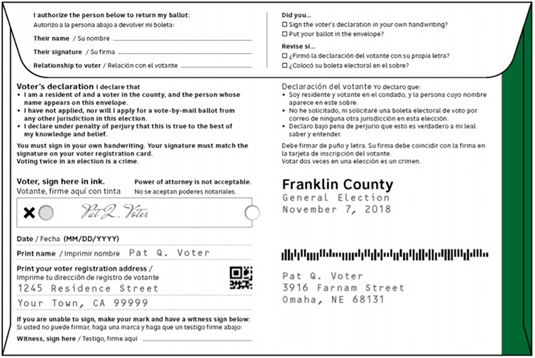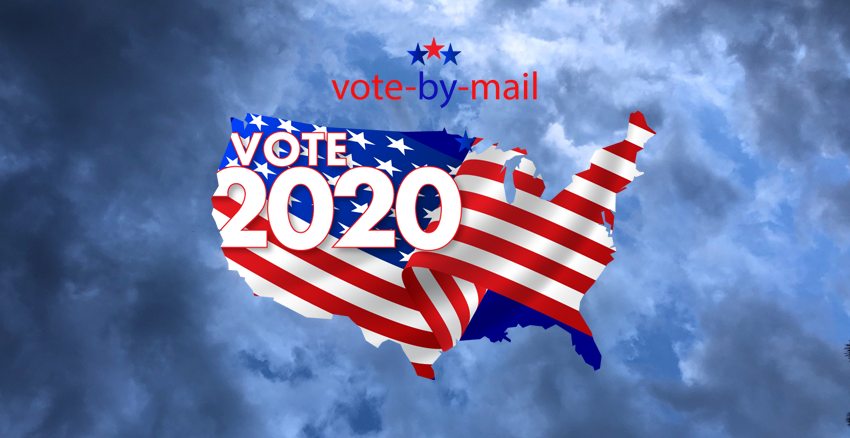The United States appears headed for an election in November 2020 that will be conducted largely using Vote-by-Mail ballots. Enquiring minds have moved beyond the FUD1 factor and now want to know: how exactly does this process work, and how does the process prevent fraud?
Vote-by-Mail (VBM) is not new in the USA. Five states already conduct their primary and general elections by mail-in ballot. Every other state at the least has a process in place to accept and validate mail-in absentee ballots.
The VBM process is straight-forward, yet it is not well-understood by the public. Here is a 12-step primer from the State of Oregon2 that is representative of what each state faces in November.
-
- Voter registration
- Print ballots
- Issue ballots by mail
- Voter completes ballot, seals and signs return envelope
- Reception of mail at election center
- Signature verification
- Open the Return Ballot Envelopes
- Ballot inspection process
- Ballot counting
- Exception handling
- Certification
- Ballot storage
Making every vote count – and counting every vote – is the ultimate mission of the VBM process. However, before a vote can be counted, first the ballot must be verified to prevent voter fraud. How is this done?
Step Six Matters Most
Every mail-in ballot must go through Step Six, a signature verification process to compare the voter’s signature with the signature on the voter’s registration card kept on file by the government election office. The signature is typically found on the back of the return ballot envelope. The voter signs a legal affidavit stating they are in fact the registered voter.
Here is a sample envelope used in the California state guideline manual.3

When the ballot is returned to the election office, election officials have a secure process for examining each signature and comparing it to other documents in their files that contain the voter signature – typically, the voter registration record.
This process of comparing and matching signatures is done by election officials or temporary election workers often working in bipartisan teams. In some states, especially those that send mail ballots to all eligible voters, the individuals responsible to verify signatures must undergo training to analyze signatures for potential fraud.
This Is Difficult
Imagine the scene: a worker sitting at a large table with a stack of envelopes on one side, and a book or computer screen of signature images on the other. The worker is expected to scrutinize each signature by following very complex expert guidelines, such as these from the State of Oregon VBM manual2, and then make an incredibly important decision to accept or reject the ballot. All under the pressure of time.
Oregon State list of characteristics for evaluating signatures:
-
-
- Broad characteristics used to evaluate the entire signature as a unit:
- Type of writing: hand printed, cursive or a mix of the two
- Speed of the writing
- Assess the appearance of the initial and terminal strokes – blunt or finely tapered
- Assess the presence or absence of changes in pen pressure
- Line quality
- Presence or absence of tremor
- Presence or absence of a tracing guideline
- Skill level of the writer
- Style of the writing
- Overall size of the writing
- Overall spacing of the writing
- Overall proportions
- Slant/Slope of the writing
- Style and construction of connecting strokes
- Position of the signature on the signature line or baseline
- Localized Examinations: specific letters or combinations of letters within a signature:
- Size
- Letters that are given preference in size or conversely, suppressed
- Internal spacing between individual letters or letter combinations
- Proportions
- Components of individual letters
- Letter combinations
- Presence or absence of pen lifts
- Letters or letter combinations that have a divergent slant/slope
- Pinpoint characteristics that are distinctive within the writer’s signature
- Broad characteristics used to evaluate the entire signature as a unit:
-
Even the fastest human will need at least ten seconds for each signature. And that’s only for a signature with obvious matching characteristics to the signature on record. Any signature with one or more dissimilarities must then be reviewed by at least two different election officials before it is accepted or rejected.
When a rejection is declared, the ballot envelope is left unopened and placed in an exception handling pile. An election official will contact each voter, explaining the problem and asking them to verify their information and that they did in fact cast the ballot. This is referred to as “curing” the ballot. If the voter doesn’t complete this verification step within the time allotted, their ballot isn’t counted.
Did My Vote Count?
To summarize, no match and no cure equal NO VOTE. This is a critical stage of the VBM process. The ability to accurately assess a signature is a major factor in validating votes and identifying fraud. So, the visual matching ability of volunteer signature matchers is very important. As with all repetitive data processing tasks performed by people, it is prone to fatigue and human error. The process can proceed only as fast as the slowest person.
An honest matching error could mean someone’s vote will not be counted. At a county election center with as few as tens of thousands of ballots to inspect, it can take several days to complete this step and move on to tabulating the results.
With all due respect given to the individual heroic efforts of these workers for which we are all grateful, this is no way to run an election in 2020. Step Six of the VBM process is a classic example of a mind-numbing, intense manual process ready for digital transformation.
The Role of Automated Signature Verification
Automated Signature Verification (ASV) technology provides the path to digital transformation. ASV machine learning-based software incorporates all the human intelligence of the step-bystep matching process seen above. It takes one or more reference signatures from voter records and compares them with the signature on the ballot to determine authenticity. The process takes less than a second for each ballot.
ASV also produces results that are not only more reliable than the results achieved with even well-trained staff, but are consistent and tamper-proof. Even if signatures look different due to changes over time, the software can adapt – looking at key, proven and hard-to-detect characteristics.
Here’s how ASV software fits into the VBM process:
-
-
- The back of the return envelope is scanned. This can be done with a COTS4 document scanner that can handle stuffed envelopes. There are many scanners available for this job. The type of scanner you select (and its cost) depends on the volume of envelopes to process per hour and the level of automation you want to achieve. A few very expensive scanners can even sort the rejected envelopes for you. The higher cost may be justified if you have one centralized processing center consolidating the ballots from several smaller jurisdictions.
- The scanned envelope image contains all the information needed to verify the signature and match it to the voter record.
- The images are opened and “read” in milliseconds by the ASV software.
- Results are reported to the operator: matched or rejected. Election officials can use other workstations to audit the rejections, which should be a much lower quantity using ASV.
- Matched envelopes can now be opened to remove and tabulate the ballots.
- A list of rejections is passed to the election official responsible for contacting the voters.
-
Go With the Best
ASV is only as useful as the science behind the technology. Parascript, a world leader in handwriting recognition and applied machine learning research, has announced a new version of its SignatureXpert that will make it even easier for election offices hard-pressed to come up with a solution in time for the November election cycle.
SignatureXpert can now evaluate ballot signatures using signatures pulled from a state’s department of motor vehicle records. With advanced machine learning image perfection, even low-resolution drivers’ license signatures can be used.
The Clock Is Ticking
Election officials need to move quickly to implement a reliable and fast signature verification process in time for the November election. Parascript and its extensive network of document imaging partners are ready to assist. Now is the time to consult an expert who can help you test and deploy a solution.
Footnotes:
1 Fear, Uncertainty and Doubt
2 https://sos.oregon.gov/elections/Documents/vbm_manual.pdf
3 https://civicdesign.org/projects/vote-by-mail/
4 Commercial Off The Shelf

